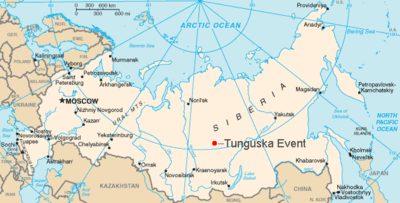തുൻഗസ്ക സംഭവം
1908 ജൂൺ 30ന് റഷ്യയിലെ മദ്ധ്യ സൈബീരിയയിലെ തുൻഗസ്ക വനപ്രദേശത്ത് ഒരു വാൽനക്ഷത്രമോ ആസ്റ്ററോയിഡോ ഭൌമാന്തരീക്ഷത്തിൽ കടന്ന് പൊട്ടിത്തെറിച്ച സംഭവമാണ് തുൻഗസ്ക സംഭവം എന്ന പേരിൽ അറിയപ്പെടുന്നത്. ഭൂതലത്തിൽനിന്ന് 8 കി.മീ. മുകളിലെത്തി, വായുവിന്റെ ഘർഷണം കൊണ്ട് ജ്വലിച്ച് പൊട്ടിത്തെറിച്ച 10 മെഗാടൺ ടി.എൻ.ടി.ക്കു തുല്യമായ ഊർജ്ജം (1500 ഹിരോഷിമാ ബോംബുകൾക്കു സമം) ചുറ്റും വിതറി. സ്ഫോടനത്തെ തുടർന്നുണ്ടായ ഷോക്ക് വേവ് രണ്ടുതവണ ഭൂഗോളത്തെ ചുറ്റി. 400 കിലോമീറ്ററിലധികം വനപ്രദേശം നശിപ്പിക്കപ്പെട്ടു. ഭൗമാന്തരീക്ഷത്തിൽ നടന്ന ചരിത്രത്തിൽ രേഖപ്പെടുത്തപ്പെട്ടതിൽ ഏറ്റവും വലിയ സ്ഫോടനമായി ഇത് കണക്കാക്കുന്നു. തുൻഗസ്ക്കയിൽ ഇതിന്റെ അടയാളങ്ങൾ ഇപ്പോഴും ബാക്കിയാണ്. [1][2][3]
| തുൻഗസ്ക സംഭവം | |
|---|---|
 തുൻഗസ്ക സംഭവം ഉണ്ടായ സ്ഥലം സൈബീരിയ (modern map) | |
| Event | Explosion in forest area (10–15 Mtons TNT) |
| Time | 30 June 1908 |
| Place | Podkamennaya Tunguska River in Siberia, Russian Empire |
| Effects | Flattening 2,000 കി.m2 (2.2×1010 sq ft) of forest; seen by glowing sunsets |
| Damage | Mostly material damages to trees |
| Cause | Probable air burst of small asteroid or comet |
അവലംബം
തിരുത്തുക- ↑ Pasechnik, I. P. Refinement of the moment of explosion of the Tunguska meteorite from the seismic data. – Cosmic Matter and the Earth. Novosibirsk: Nauka, 1986, p. 66 (in Russian).
- ↑ P. Farinella, L. Foschini, Ch. Froeschlé, R. Gonczi, T. J. Jopek, G. Longo, P. Michel Probable asteroidal origin of the Tunguska Cosmic Body
- ↑ Trayner, C. Perplexities of the Tunguska meteorite